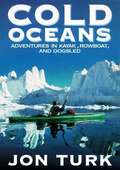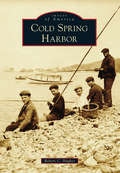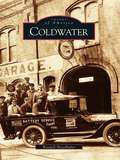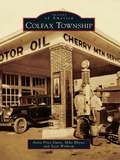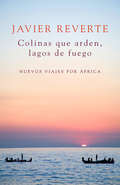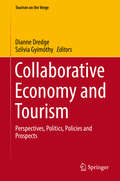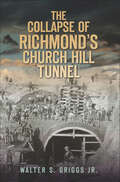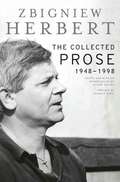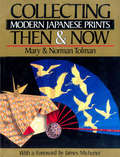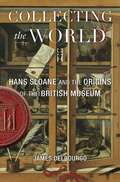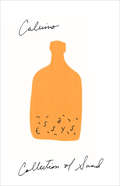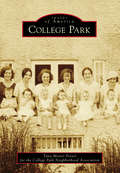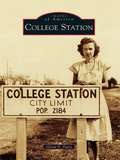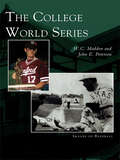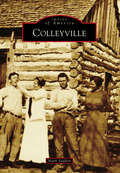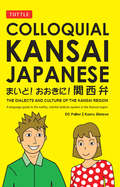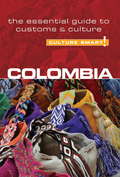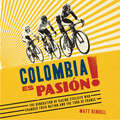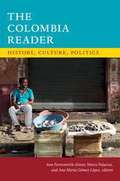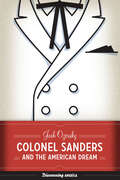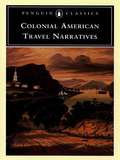- Table View
- List View
Cold Oceans
by John TurkFrom its opening passages, Jon Turk's Cold Oceans chronicles explorations in both exterior and interior landscapes. In honest, accessible prose, Turk retraces more than two decades of his varied and stirring adventures--attempting to round Cape Horn solo in a kayak, rowing the Northwest Passage, dogsledding the east coast of Baffin Island, and kayaking from Ellesmere Island to Greenland. As Turk plunges headlong through icy seas, repeated and assorted blunders, and bouts of personal lows, he transcends mere adventure storytelling to explore a changing notion of himself, deepening relationships, and the nature of failure and true success. These passages contain some of Cold Oceans's greatest riches.
Cold Spring Harbor
by Robert C. HughesA bustling industrial community in the 19th century, Cold Spring Harbor was once described as "a sweet bay of beauty." The area briefly served as a whaling port and was a center for shipbuilding, milling, and farming. Located just 35 miles from midtown Manhattan, Cold Spring Harbor was a fashionable summer resort for New York City residents who came to the area during the Gilded Age to enjoy the cool breezes off the shores of the harbor. Today, Cold Spring Harbor is a residential community with excellent schools, active organizations, museums, and the world-renowned Cold Spring Harbor Laboratories. Cold Spring Harbor traces the development of the area from its days as a bustling whaling port to a 20th-century suburbanized community.
Coldwater (Images of America)
by Randall HazelbakerThe Coldwater area was first settled on the historic Sauk Trail in the 1830s. Coldwater became a village in 1837, and after the arrival of the railroads in the 1850s, it became a city in 1861. Majestic homes and buildings were constructed, churches and schools were established, and a vibrant community began to take shape. The 1900s brought more growth and challenges, as residents encountered the Great Depression, World War II, and subsequent eras of transition, renewal, and expansion. This book showcases a rare collection of historic images to document Coldwater's progress and development throughout the 20th century.
Colerain Township
by Frank Scholle Don LinzColerain Township, the largest township in the state of Ohio, was founded in 1794. The first settlement in the township was in 1790, where John Dunlap and a small band of settlers built a little fort on the Great Miami River and named it Fort Coleraine. Later the settlement became known as Dunlap's Station. The township was primarily a rural farming area until the 1950s, when builders began to develop subdivisions. Businesses sprang up and shopping areas followed. From 1950 to 1960, the population almost quadrupled. Today Colerain is a bustling community with several shopping centers, major businesses, and around 63,000 residents.
Colfax County
by Stephen Zimmer Gene LammIn 1841, Carlos Beaubien and Guadalupe Miranda received a grant of land from the governor of New Mexico in the northeastern part of the Mexican province. Frontier conditions prevented colonization of the grant until 1848, when Beaubien's son-in-law Lucien Maxwell led settlers from Taos to the Rayado River where it crossed the Santa Fe Trail. Maxwell's friend Kit Carson joined him the following year, and their ranch prospered in spite of frequent attacks by Jicarilla Apaches. Later, Maxwell moved north to the Cimarron River. Gold was discovered on the western part of the grant in 1866, and miners rushed to the diggings, establishing the town of Elizabethtown. It became the first seat of Colfax County in 1869. Maxwell sold the grant to foreign investors who organized the Maxwell Land Grant and Railway Company in 1870 and founded the town of Cimarron. The Santa Fe Railroad entered the county in 1879, which precipitated the creation of the towns of Raton and Springer and also fostered large-scale ranching, mining, and lumbering.
Colfax Township
by Anita Price Davis Scott Withrow Mike RhyneLocated at the Rutherford-Cleveland County line, Colfax Township was a response to the 1868 state mandate to divide North Carolina counties into townships. Colfax Township took its name from Schuyler Colfax, the 17th vice president of the United States (1869-1873). The 53.1 square miles of the township remain mainly rural, and most residents have lived here for five years or more. Such stability generates community pride and considerable participation in Big Days, the Colfax Free Fair, the Fiddler's Conventions, and other celebrations. The Colfax Museum reflects the interest in the area. Images of America: Colfax Township--a pictorial retrospective--celebrates the life and times of the area.
Colinas que arden, lagos de fuego: Nuevos viajes por África
by Javier Reverte«Volver a las colinas, las praderas, los bosques y los lagos del este de África, después de varios años de ausencia, acelera los latidos del corazón y renueva los fluidos del espíritu. Además de eso, recorrer a pie alguno de sus senderos, igual que lo hicieron los antiguos exploradores, resulta tan emocionante como diferente a otro tipo de viaje.»Javier Reverte Diez años después de publicarse Los caminos perdidos de África, Javier Reverte regresa con Colinas que arden, lagos de fuego. Las escalas de este nuevo viaje narran su paso por el fantasmal lago Turkana, en el norte de Kenia, por el Tanganika, en Tanzania, o Chitambo, la pequeña aldea de Zambia donde murió David Livingstone y quedó enterrado su corazón. Javier Reverte, maestro de la literatura de viajes en lengua española, nos relata con una prosa muy personal y alejada de tópicos se reencuentro con los habitantes y paisajes del África de nuestros días, salpicándolos con pinceladas del pasado del continente negro, del colonialismo europeo y la época de las exploraciones. Sin caer en el patetismo o la blandura, el autor recoge la cara y la cruz, las sombras y las luces de un continente tan sufrido como hermoso. El humor, la ternura, la épica y la sensualidad se mezclan en este extraordinario libro de viajes de la mano de un escritor inimitable que se ha ganado el afecto de miles de lectores. Reseñas:«La gran literatura de viajes en lengua española.»ABC Cultural «La narración de estos cuatro viajes por algunos de los escenarios más bellos, salvajes y asombrosos de África destila aventura y contagia vitalidad. Un precioso relato que alcanza y describe la esencia de África.»Viajar «Como siempre con el flâneur Reverte, la gente con la que intima en el camino es de lo mejor de la experiencia.»El País
Collaborative Economy and Tourism
by Dianne Dredge Szilvia GyimóthyThis book employs an interdisciplinary, cross-sectoral lens to explore the collaborative dynamics that are currently disrupting, re-creating and transforming the production and consumption of tourism. House swapping, ridesharing, voluntourism, couchsurfing, dinner hosting, social enterprise and similar phenomena are among these collective innovations in tourism that are shaking the very bedrock of an industrial system that has been traditionally sustained along commercial value chains. To date there has been very little investigation of these trends, which have been inspired by, amongst other things, de-industrialization processes and post-capitalist forms of production and consumption, postmaterialism, the rise of the third sector and collaborative governance. Addressing that gap, this book explores the character, depth and breadth of these disruptions, the creative opportunities for tourism that are emerging from them, and how governments are responding to these new challenges. In doing so, the book provides both theoretical and practical insights into the future of tourism in a world that is, paradoxically, becoming both increasingly collaborative and individualized.
The Collapse of Richmond's Church Hill Tunnel (Disaster)
by Walter S. Griggs Jr.Explore the facts and mysteries surrounding the history and collapse of Richmond, Virginia's Church Hill Tunnel. A must for fans of railroad and Richmond history.Richmond, the capital of the Confederacy, was in shambles after the Civil War. The bulk of Reconstruction became dependent on the railways, and one of the most important links in the system was the Church Hill Tunnel. The tunnel was eventually rendered obsolete by an alternative path over a viaduct, and it was closed for regular operation in 1902. However, the city still used it infrequently to transport supplies, and it was maintained with regular safety inspections. The city decided to reopen the tunnel in 1925 due to overcrowding on the viaduct, but the tunnel needed to be strengthened and enlarged. On October 2, 1925, 190 ft. of the tunnel unexpectedly caved in, trapping construction workers and an entire locomotive inside.In recent years, there has been a renewed interest in the tunnel and the mystery surrounding its collapse. There were cave-ins and sink holes above the surface for decades after the tunnel was sealed up, and in 1998, a reporter from the Richmond Times-Dispatch did an investigation, trying to determine the current condition of the tunnel. In 2006, the Virginia Historical Society announced its efforts to try and excavate the locomotive and remaining bodies.
The Collected Prose: 1948-1998
by Zbigniew HerbertPolish poet and essayist Zbigniew Herbert easily stands beside Nobel Prize laureates Milosz and Szymborska as part of a remarkable literary tradition. Though Herbert is very much an Eastern European writer, the urgency, vitality, and relevance of his work extend far beyond the borders of his particular region and his particular time. His fascination with other subjects--from painting to all things Dutch--enriched the scope and depth of his poetry, and made for compelling explorations in his essays and short prose pieces. The first collected English edition of his prose work, this outstanding volume consists of four books--Labyrinth on the Sea, Still Life with a Bridle, King of the Ants, and Barbarian in the Garden. Brilliant and erudite, dazzling and witty, these essays survey the geography of humanity, its achievements and its foibles. From Western civilization's past, as witnessed through the Greek and Roman landscape, to musings on the artistic that celebrate the author's discriminating eye, poetic sensibility, and gift for irony, humor, and the absurd; from a sage retelling of myths and tales that became twentieth-century philosophical parables of human behavior to thoughts on art, culture, and history inspired by journeys in France, Italy, and the Netherlands, Collected Prose is a rich compendium that celebrates the mastery and wisdom of a remarkable artist.
Collecting Modern Japanese Prints
by James A. Michener Norman Tolman Mary TolmanThis book contains several bodies of information. An introductory essay puts Japanese prints into historical perspective and gives a brief outline of techniques. The second section, "Then," illustrated with prints by the older masters of the twentieth century, seeks to describe how we went about putting together our collection. There should not be many surprises here since these artists, many in their seventies, eighties, and nineties, will be known andeasily recognized by anyone who has even a minor interest in modern Japanese prints. These artists have been written about at great length elsewhere, though not perhaps from our unique viewpoint as collectors and dealers.The following section, "Between Then and Now," is a lengthy essay meant to be amusing. In this book about collecting, this essay gives a play-by-play description of a collector and his determined search for a specific print. It was not intended to be the ultimate in name-dropping, but was included to indicate the esteem and admiration that Japanese prints command abroad.The last section, "Now," using fifty artists with fifty illustrations to explain specific points about print collecting, gives not only objective facts about each artist and his work but also includes anecdotes that may help a collector better recognize and remember them. Some of these artists have already been briefly mentioned in the "Then" section. We wish to state that not all of the artists talked about are artists whom we handle in our gallery; we also hasten to point out that ail of the artists whom we do carry are, of course,included here. We have presented all of the prints in full color, in as large aformat as possible, so that the art lover can savor the details of each work.
Collecting The World: Hans Sloane And The Origins Of The British Museum
by James DelbourgoIn 1759 the British Museum opened its doors to the general public--the first free national museum in the world. James Delbourgo's biography of Hans Sloane recounts the story behind its creation, told through the life of a figure with an insatiable ambition to pit universal knowledge against superstition and the means to realize his dream. Born in northern Ireland in 1660, Sloane amassed a fortune as a London society physician, becoming a member of the Whig establishment and president of the Royal Society and Royal College of Physicians. His wealth and contacts enabled him to assemble an encyclopedic collection of specimens and objects--the most famous cabinet of curiosities of its time. For Sloane, however, collecting a world of objects meant collecting a world of people, including slaves. His marriage to the heir of sugar plantations in Jamaica gave Sloane access to the experiences of planters and the folkways of their human property. With few curbs on his passion for collecting, he established a network of agents to supply artifacts from China, India, North America, the Caribbean, and beyond. Wampum beads, rare manuscripts, a shoe made from human skin--nothing was off limits to Sloane's imagination. This splendidly illustrated volume offers a new perspective on the entanglements of global scientific discovery with imperialism in the eighteenth century. The first biography of Sloane based on the full range of his writings and collections, Collecting the World tells the rich and complex story of one of the Enlightenment's most controversial luminaries.
Collection of Sand: Essays (Penguin Modern Classics Ser.)
by Italo CalvinoThis &“brilliant collection of essays&” and travelogues by the celebrated author of Invisible Cities &“may change the way you see the world around you&” (The Guardian, UK). Italo Calvino&’s boundless curiosity and ingenious imagination are displayed in peak form in Collection of Sand, his last collection of new works published during his lifetime. Delving into the delights of the visual world—both in art and travel—the subjects of these 38 essays range from cuneiform and antique maps to Mexican temples and Japanese gardens. In Calvino&’s words, this collection is &“a diary of travels, of course, but also of feelings, states of mind, moods…The fascination of a collection lies just as much in what it reveals as in what it conceals of the secret urge that led to its creation&” (from Collection of Sand). Never before translated into English, Collection of Sand is an incisive and often surprising meditation on observation and knowledge, &“beautifully translated by Martin McLaughlin&” (The Guardian, UK).
College Park (Images of America)
by Tana Mosier Porter College Park Neighborhood AssociationCollege Park has the look and feel of small-town America, with its central business district and tree-lined residential streets, schools and churches, and strong sense of community. College Park, though, was never a town; it developed as a neighborhood within the city of Orlando. The name originated not with a college but instead with a developer, who gave the streets in his new subdivision college names in 1921. In 1925, another developer named the first of several subdivisions College Park. The name caught on and became official with the naming of the College Park Post Office in 1954. Images of America: College Park commemorates 90 years of its history and community. From the 19th-century citrus groves, to new subdivisions in the 1920s, to tract housing in the 1940s and 1950s, College Park evolved as a desirable place for families.
College Station
by Glenn D. DavisThe first land-grant college in Texas--called the Agricultural and Mechanical College--was predominantly a military school, built in 1876 in a then-remote area of Central Texas. Like other developments, the institute was a result of the expanding railroad, so a station named "College" was erected to service the new school. Drawing newcomers to the area, the city of College Station was incorporated in 1938, and its size soon rivaled that of neighboring Bryan--the Brazos County seat. The College Station area offers a surprisingly diverse mix of attractions, including the George Bush Presidential Library, the Texas Motor Speedway, and Kyle Field. During the last century, the college has grown from a few hundred students into a major university with more than 49,000 students, making Texas A&M the seventh-largest school in the nation. Today College Station is home to some 100,000 people.
College World Series, The (Images of Baseball)
by W. C. Madden John E. PetersonSince 1950, Omaha's Rosenblatt Stadium (formerly Municipal Stadium) has hosted the nation's top college baseball programs in the College World Series. Baseball fans from every corner of the country have taken the annual "Road to Omaha" and packed the seats to see championship baseball at its best. In 1954 thousands saw Jim Ehrler of Texas toss the tourney's first no-hitter en route to the Longhorns winning back-to-back CWS championships. Fans at the 1970 tournament saw Southern Cal defeat Florida State in the midst of their unmatched five-year championship run. In 1996 Rosenblatt's faithful took in the dramatic bottom-of-the-ninth, two-out, two-run homer by Louisiana State's Warren Morris, giving his team a 9-8 upset victory over powerhouse Miami.
Colleyville (Images of America)
by Mark FaddenRanked by multiple magazines, including Money and D Magazine, as one of the "Best Places to Live" in the United States, it is easy to forget where Colleyville came from. A rural farming outpost that started out as six different "parent communities," residents eventually banded together and incorporated to become Colleyville in 1956. While Colleyville is named for Dr. Lilburn Howard Colley, entire generations of Colleyville citizens have displayed his spirit of hard work, determination, and caring for this city. From a few clusters of pioneering families to a close-knit community known for its dairy farms and horse racing track to becoming one of the nation's premier cities, Colleyville's population has grown from about 1,500 in 1960 to more than 24,000 today.
Colloquial Kansai Japanese
by D. C. Palter Kaoru SlotsveThis is a compact and convenient guide to learning the Kansai dialect of the Japanese languageMaido, maido and welcome to the Kansai region of western Japan. Whether visiting or living in this area, you will quickly notice the locals aren't speaking standard Japanese taught in textbooks and classrooms. The language on the streets is Kansai-ben: a dialect said to be earthier and more direct, but with its own polite langauge.With clear explanations of grammar, a Kansai-ben dictionary, and a helpful index, Colloquial Kansai Japanese is an indispensable guide to the rich speech of Kyoto, Osaka and Kobe. Hundreds of sample phrases, sentences and conversations show how the dialect works in everyday situations, ranging from shopping to dealing with the boss. And while you're leaning about the nuances of Kansai-ben, you will have fun reading about Kansai cuisine, sports and specialities.So open your mouth when you speak, roll your r's, and try out this colorful dialect. With your copy of Colloquial Kansai Japanese, you will soon be among friends in Kansai.
Colombia - Culture Smart!
by Kate CatheyColombia is a magical country, full of spectacular varied landscapes, rare ecosystems, succulent tropical fruits, salsa and cumbia music, and kind, fun-loving people. The modern culture is a synthesis of Spanish, indigenous, and African traditions, evident in the music, the food, and Barranquilla's famous Carnaval. The country's major cities are modern and cosmopolitan, with an international style and consumerism that makes them feel more like cities in the USA than Latin America. Yet, five minutes into the countryside, its distinct rural charms reveal a slower and more bucolic past. In the collective imagination, Colombia is exotic, lawless, and dangerous--an illegal narcotics trade and the ongoing armed conflict have contributed to its bad-boy image. But things are changing, and there is so much more than that. Entrenched social inequality has led to strife, manifest in the long-lived left- and rightwing rebel movements and a cycle of appalling violence that has saturated four decades with an undeclared civil war. And still, the Colombians are animated, lighthearted and fun--always ready to laugh and enjoy the moment. They have found strength in each other, in their families, and closest friends who are the cornerstones of their lives. Culture Smart! Colombia shows how the country's rough geography and tumultuous history have shaped modern values and attitudes. It looks at the public realm and at life at home with the family. It introduces you to Colombia's distinct and delicious cuisine, and reveals what people think about each other, their neighbors, and foreigners. There is advice on the safest ways to get around; on how business is done; and how Colombians communicate. Culture Smart! Colombia explains the intricacies of a culture that is both modern and steeped in tradition, international and regional, cosmopolitan and agrarian, very rich and very poor, and after more than four decades of undeclared civil war is happily emerging from tough times and getting ready for the future.
Colombia Es Pasion!: The Generation of Racing Cyclists Who Changed Their Nation and the Tour de France
by Matt RendellBy winning the 2019 Tour de France, Egan Bernal became the race's youngest champion in 110 years, and the first from the South American nation of Colombia. His victory brought decades of national yearning to fruition, and capped the achievements of a golden generation of Colombian cyclists.For, in the years before Egan's victory, Nairo Quintana won the Tours of Italy and Spain, even coming within 72 seconds of winning the Tour. Rigoberto Urán, Esteban Chaves, Miguel Ángel López and Fernando Gaviria took stage wins, donned leader's jerseys and made final podiums at cycling's greatest events. They, and other world-class Colombian talents, made their nation a cycling superpower. Yet its cycling sons are not the products of a rigorous sports system that nurtures them through the ranks to the pinnacle of globalised sport. They come from harder backgrounds, that surprise, shock - even, at times, enchant. The visibility they have secured their homeland has helped open it to international tourism and trade. After decades of violence, corruption and civil unrest, a new, revitalised Colombia has re-entered the community of nation, thanks to its cyclists.This book is about their lives and dreams: it tells inspiring stories of overcoming poverty and violence, sickness and corruption. It explores the unique sporting microcosm that lies behind Colombia's world-beating riders, and how their achievements spurred a nation to prosperity and peace.
Colombia Es Pasion!: The Generation of Racing Cyclists Who Changed Their Nation and the Tour de France
by Matt RendellBy winning the 2019 Tour de France, Egan Bernal became the race's youngest champion in 110 years, and the first from the South American nation of Colombia. His victory brought decades of national yearning to fruition, and capped the achievements of a golden generation of Colombian cyclists.For, in the years before Egan's victory, Nairo Quintana won the Tours of Italy and Spain, even coming within 72 seconds of winning the Tour. Rigoberto Urán, Esteban Chaves, Miguel Ángel López and Fernando Gaviria took stage wins, donned leader's jerseys and made final podiums at cycling's greatest events. They, and other world-class Colombian talents, made their nation a cycling superpower. Yet its cycling sons are not the products of a rigorous sports system that nurtures them through the ranks to the pinnacle of globalised sport. They come from harder backgrounds, that surprise, shock - even, at times, enchant. The visibility they have secured their homeland has helped open it to international tourism and trade. After decades of violence, corruption and civil unrest, a new, revitalised Colombia has re-entered the community of nation, thanks to its cyclists.This book is about their lives and dreams: it tells inspiring stories of overcoming poverty and violence, sickness and corruption. It explores the unique sporting microcosm that lies behind Colombia's world-beating riders, and how their achievements spurred a nation to prosperity and peace.
Colombia Es Pasion!: The Generation of Racing Cyclists Who Changed Their Nation and the Tour de France
by Matt RendellBy winning the 2019 Tour de France, Egan Bernal became the race's youngest champion in 110 years, and the first from the South American nation of Colombia. His victory brought decades of national yearning to fruition. Colombia has long been the only developing nation contending at cycling's highest level. Yet its cycling sons are not the products of a rigorous sports system that spots them in childhood and nurtures them through the ranks to the pinnacle of globalised sport. They come from harder backgrounds, that surprise, shock - even, at times, enchant.Colombia Es Pasión! explores the lives and dreams of each of the nation's leading cyclists. Theirs are inspiring stories of overcoming poverty and violence, sickness and corruption, and achieving global sporting glory.'Takes you into the heart of both a sport and a country. The journey is well worth the effort' Sunday Times'Wonderful' Observer'Remarkable, a masterpiece' Never Strays Far podcast
The Colombia Reader: History, Culture, Politics
by Ana María Gómez López Ann Farnsworth-Alvear Marco PalaciosContaining over one hundred selections--most of them published in English for the first time--The Colombia Reader presents a rich and multilayered account of this complex nation from the colonial era to the present. The collection includes journalistic reports, songs, artwork, poetry, oral histories, government documents, and scholarship to illustrate the changing ways Colombians from all walks of life have made and understood their own history. Comprehensive in scope, it covers regional differences; religion, art, and culture; the urban/rural divide; patterns of racial, economic, and gender inequalities; the history of violence; and the transnational flows that have shaped the nation. The Colombia Reader expands readers' knowledge of Colombia beyond its reputation for violence, contrasting experiences of conflict with the stability and significance of cultural, intellectual, and economic life in this plural nation.
Colonel Sanders and the American Dream (Discovering America)
by Josh OzerskyFrom Aunt Jemima and Uncle Ben to the Jolly Green Giant and Ronald McDonald, corporate icons sell billions of dollars' worth of products. But only one of them was ever a real person-Colonel Sanders of Kentucky Fried Chicken/KFC. From a 1930s roadside café in Corbin, Kentucky, Harland Sanders launched a fried chicken business that now circles the globe, serving "finger lickin' good" chicken to more than twelve million people every day. But to get there, he had to give up control of his company and even his own image, becoming a mere symbol to people today who don't know that Colonel Sanders was a very real human being. This book tells his story-the story of a dirt-poor striver with unlimited ambition who personified the American Dream. Acclaimed cultural historian Josh Ozersky defines the American Dream as being able to transcend your roots and create yourself as you see fit. Harland Sanders did exactly that. Forced at age ten to go to work to help support his widowed mother and sisters, he failed at job after job until he went into business for himself as a gas station/café/motel owner and finally achieved a comfortable, middle-class life. But then the interstate bypassed his business and, at sixty-five, Sanders went broke again. Packing his car with a pressure cooker and his secret blend of eleven herbs and spices, he began peddling the recipe for "Colonel Sanders' Kentucky Fried Chicken" to small-town diners in exchange for a nickel for each chicken they sold. Ozersky traces the rise of Kentucky Fried Chicken from this unlikely beginning, telling the dramatic story of Sanders' self-transformation into "The Colonel," his truculent relationship with KFC management as their often-disregarded goodwill ambassador, and his equally turbulent afterlife as the world's most recognizable commercial icon.
Colonial American Travel Narratives
by Various Susan Imbarato Wendy MartinFour journeys by early Americans Mary Rowlandson, Sarah Kemble Knight, William Byrd II, and Dr. Alexander Hamilton recount the vivid physical and psychological challenges of colonial life. Essential primary texts in the study of early American cultural life, they are now conveniently collected in a single volume.
